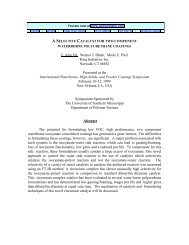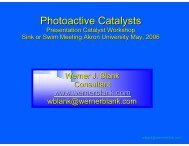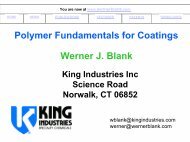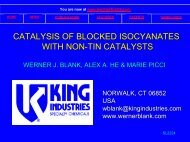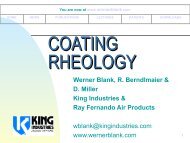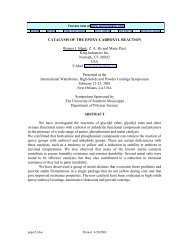Catalysis of the Isocyanate-Hydroxyl Reactions ... - Wernerblank.com
Catalysis of the Isocyanate-Hydroxyl Reactions ... - Wernerblank.com
Catalysis of the Isocyanate-Hydroxyl Reactions ... - Wernerblank.com
Create successful ePaper yourself
Turn your PDF publications into a flip-book with our unique Google optimized e-Paper software.
300<br />
420<br />
TACK-FREE Time (min.)<br />
240<br />
180<br />
120<br />
60<br />
0<br />
0 0.005 0.01 0.015 0.02<br />
CATALYST CONC. Me %<br />
TACK-FREE TIME (min.)<br />
360<br />
300<br />
240<br />
180<br />
120<br />
60<br />
0<br />
0 0.1 0.2 0.3 0.4 0.5<br />
CATALYST, CONC. Me %<br />
ZIRC B ZIRC A DBTDL<br />
SL2077F<br />
Bi oct Al ch1<br />
SL2078F<br />
Figure 8. Tack-free time <strong>of</strong> acrylic/HDI trimer, gel time<br />
for ZIRC A & B and DBTDL<br />
Figure 9. Tack-free time <strong>of</strong> acrylic/HDI trimer, gel time<br />
for bismuth and Alch1 catalyst<br />
Figure 10 and 11 give <strong>the</strong> dry time for ZIRC A & B, DBTDL and for bismuth and AlCh1<br />
catalyst.<br />
DRY-THROUGH Time ( min.)<br />
420<br />
360<br />
300<br />
240<br />
180<br />
120<br />
60<br />
0<br />
0 0.005 0.01 0.015 0.02<br />
CATALYST, CONC Me %<br />
ZIRC B ZIRC A DBTDL<br />
DRY-THROUGH Time (min.)<br />
360<br />
300<br />
240<br />
180<br />
120<br />
60<br />
0<br />
0 0.1 0.2 0.3 0.4 0.5<br />
CATALYST CONC. Me, %<br />
Bi oct Al ch1<br />
SL2076F<br />
Figure 10. Dry-through time <strong>of</strong> acrylic/HDI trimer, gel<br />
time for ZIRC A&B and DBTDL<br />
Figure 11. Dry-through time <strong>of</strong> acrylic/HDI trimer, gel<br />
time for bismuth and Alch1 catalyst<br />
The time required for a doubling in viscosity for a polyester/HDI-trimer in <strong>the</strong> presence <strong>of</strong> DBTDL<br />
and AlCh1 catalyst in <strong>the</strong> presence <strong>of</strong> different levels <strong>of</strong> 2,4-pentanedione is shown in Figure 12.<br />
The catalyst level in <strong>the</strong> formulation for DBTDL is 0.0042 % Sn on resin and for AlCh1 is 0.052 %<br />
Al on resin. The level <strong>of</strong> 2,4-pentanedione was 0, 0.58, 1.23 and 1.8% on resin solids or a molar<br />
ratio <strong>of</strong> tin to pentanedione 0, 163, 345 and 505; for <strong>the</strong> aluminum chelate <strong>the</strong> ratio was 0, 3, 6.4<br />
and 9.3. The same experiment was also conducted for <strong>the</strong> bismuth catalyst and no increase in<br />
potlife was observed.<br />
The relative rate <strong>of</strong> reaction <strong>of</strong> n-butyl isocyanate with 2-ethylhexanol and water was measure by<br />
FT-IR in a THF solution using DBTDL and ZIRC A catalyst. The IR shows a clear reduction in<br />
urea formation with <strong>the</strong> ZIRC A catalyst <strong>com</strong>pared to DBTDL (Figure 13).



